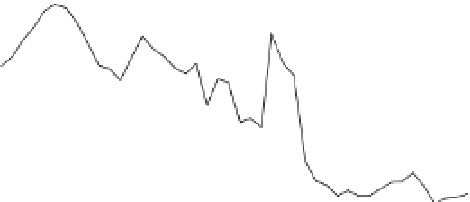Agriculture Reference
In-Depth Information
120000
100000
80000
60000
40000
20000
0
1961
1966 1971 1976 1981
Year
1986 1991 1996 2001
Eastern Europe
China
World
Fig. 16.1.
World production of hemp seeds.
Source
:
http://faostat.fao.org.
crop, mostly for bird food. Much smaller quan-
tities were produced in France, for example, as
a by-product of hemp fibre for pulp and used
for fish and bird food.
short shelf life, unpleasant taste and were not
well accepted by consumers. In addition, many
of the varieties grown in China and even in the
EU contained sufficiently high levels of THC to
produce measurable amounts of the drug in
the seeds and oil. This created concern with
the authorities about inadvertent exposure of
consumers to THC, the resulting health impacts
and the potential for producing false positive
results in workplace drug tests for marijuana,
which are common in the USA.
This situation has changed since commer-
cial hemp farming became legal again in
Canada and as European hemp producers
increasingly began harvesting and utilizing
hemp seeds as a food source and for use in
cosmetics. The following gives a brief overview
of developments in North America and Europe,
the two major emerging markets for hemp
foods and cosmetics.
16.2
Revival of Hemp Foods
This situation changed as Europeans and North
Americans rediscovered hemp stalks in the
early 1990s as a versatile source of fibre and
hurds. Subsequently, more attention was also
paid to the nutritional composition of hemp
seeds, particularly of their fatty acid spectrum,
which was found to have a unique and possibly
health-promoting balance of omega-3 and
omega-6 fatty acids. Because of the 'hemp
hype' in the mid-1990s and these early find-
ings on potential health benefits, whole hemp
seeds and cold-pressed hemp oil items became
available in North America and in Germany
and the UK. Initially, seeds and oil came from
China and Eastern Europe. Because of their
high content of triple-unsaturated fatty acids,
hemp seeds and oil are very sensitive to oxida-
tion, that is, their fat becomes rancid if the
seeds are not stored and processed properly.
Particularly in China, quality control for bird-
seed was not a high priority. Consequently,
seeds and oil were often of poor quality, had a
16.2.1 North America
The 1998 legalization of commercial hemp
farming in Canada has affected global trends
strongly in the production and use of hemp.
While Canadian hemp acreage in 1998-2000
was driven largely by speculation, since 2001,
the total hemp farming area has increased
































































































